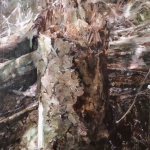July 17 – August 16, 2020
Zoom Artist Talk: July 26, 2020 at 2pm
Skills for Solitude Workshop: August 8 at 11am
Forest Skin is an exhibition of work by Squamish-based artist Veronica Trujillo.
Forest Skin was born between thoughts and daily walks as an exercise in approaching the environment and its community where she currently lives. Starting from the notion of exploring the human-landscape interaction through painting. The landscape observes us with an external face that has been formed with the time. Not only naturally but also by the uninterrupted human persistence. These appearances, as we find them today, conserve ruins of previous states. The layers of time coexist in the present. Even still within the structure in which we live, where each element changes assiduously, driven by the productivity and manipulation of the earth. The constancy of the past remains in the forms that make up the current landscape. The marks we have left is what this work attempts to delineate , in a conversation with the memory of the subject in its place. I recreate pictorial analogies with matter. Allusions to the colours of our skin and transferring them with a gesture, a stain, and a mark to the skin of forest. Building through portraits a metaphor for affinity, suggesting a resemblance between us and the vestiges of the landscape. Isolated figures inspired by the remnants of forestry harvest that occurred years ago in the area.
Veronica Trujillo was born in Mexico City, and during her childhood, she and her family lived in five different cities across Mexico. She currently lives and works in Squamish, BC. Her nomadic life has influenced and shaped her perception, interests, and relationships with the world, from the delicate and intricate transformations of her own experience to the sacred learning of nature.
These experiences enable her to reflect on the interweaving of social and natural factors that shape her surroundings and deepen her search and observations for a sense of belonging. The glance to the outside world is the root of her pictorial practice, characterized by a convergence of contemplation, thoughts, and the act of painting. She aims to prolong the duration of these ephemeral moments with the environment to allow them to take on a life beyond her own memory. Her production starts from in situ evocations as conductive axes. She explores with painting the landscape’s expressions, in an attempt to understand the link between the territory and its inhabitants. The pictorial matter becomes essential, harnessing the stain as communicative resource, means to convey symbolic links with a metaphorical sense. The gesture of elegy is the path she chooses for her practice and the need to attend in a conscious manner to one’s own time.



